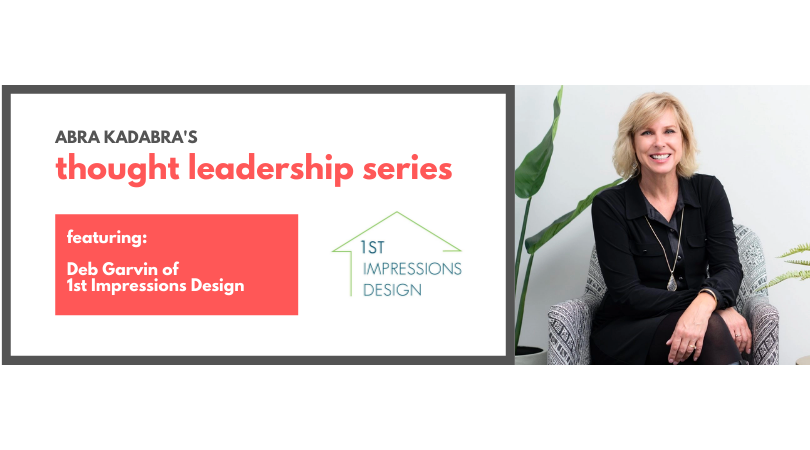Although the pandemic is slowly winding down, we’re still spending a lot more time at home than we used to – and many of us are ready to change things up. That’s where Deb Garvin comes in.
“We don’t always realize how much our surroundings can affect us mentally and emotionally,” said Garvin, the founder and owner of Minneapolis-based 1st Impressions Design. “After a long day dealing with the demands of work and family, our buckets can get emptied so when we can go home and sit in a space that is relaxing, it can go a long way toward helping us refill those buckets.”

Garvin, who has a background in education, has always been passionate about design and would often help her friends and family with their home projects for free. About five years ago, she decided to take the plunge and launch her own company. “Sometimes that’s courage and sometimes that’s ignorance and sometimes it’s a bit of both,” she said with a laugh. Now, she uses many of the skills she gained as an educator to work more effectively with her clients.
“I consider myself a collaborator and an educator,” Garvin said. “I like to keep my clients informed so they understand why I’m making the recommendations I’m making. When you can bring your clients along on the journey with you, it works better for everybody.”
For Garvin, that journey starts with a 30-minute discovery call where prospective clients will talk with her about their projects and their desired outcomes. Garvin will also share the services she provides which range from basic consultations to full-scale design work so clients can pick and choose what works best for them. And from the very beginning, Garvin is focused on building trust and establishing a connection with the client.
“You do have a relationship with them because they’re telling you all the problems they’re having and what they’re hoping to achieve through their project,” she said. “They really are sharing all their hopes and dreams with you.”
Building Strong Client Relationships
If you’re looking for ways to build stronger relationships with your clients, here are some of Garvin’s tips and recommendations:
- Be empathetic, understanding and willing to listen: In addition to simply wanting a fresh new look, many of Garvin’s clients are looking for ways to make their homes more functional. They may be dealing with a significant life change that has necessitated a redesign. Or it could be a situation where a couple wants different things from the project and there is some tension in the home. That’s where empathy and understanding come in. By leading with kindness and doing more listening than talking, you can get to the heart of what your clients need even if they may not be sure themselves. And, if necessary, figure out creative solutions so everyone can get what they want and be happy at the end of the project.
- Ask lots of questions: Garvin spends a lot of time asking questions of her clients so she can get a greater understanding of their vision as well as the problems they’re hoping to solve, their timeline and their budget. These questions not only serve as a way to facilitate the conversation and keep it moving, but they can also spark new ideas. “I think we get so eager to share our expertise that we end up missing out on what the clients want,” she said. “That’s why you have to ask a lot of questions because people don’t always volunteer the information until you ask the question.” To ensure she doesn’t miss anything, Garvin has developed an extensive questionnaire that covers all the potential bases a project might involve. “Otherwise,” she said, “assumptions are made and we all know how that goes.”
- Keep the lines of communication open: Once the project begins, Garvin makes sure her clients know they can always reach out when they have questions or concerns. In addition to using technology such as collaborative design boards, she encourages them to contact her via text, phone or email when they need her. This does two things. First, it demonstrates her level of commitment to her clients. Second, it prevents miscommunication and ensures that everyone is on the same page.
- Show your value and be up front: When Garvin talks about pricing with new clients, she makes a point to explain how her pricing is tied to the value she brings to the table. She also goes over her services in detail and the costs associated with each of them. That way, if someone adds on a service, they know up front they will be paying more. “If you have that understanding from the get go and the person understands the value they’re getting from the additional costs, then there won’t be any unpleasant surprises,” she said. “It’s all about setting expectations.”
- Follow up: Working on an interior design project can be an intimate and intense experience and when it’s over, Garvin doesn’t believe in just walking away. For example, she’ll often provide referrals to other home service providers such as painters or electricians and then she’ll follow up with her client to see how everything worked out. She also likes to touch base to see how the design project is working out for them now that they’re actually living in the space. “They’re always appreciative that I check in with them,” she said. “And it’s important for me that they know I really do care that things are going well for them and that in the end, they got the result they were hoping for.”
Abra Kadabra Environmental Services is proud to share the wisdom of business owners from our community through our thought leadership series. If you’d like to be featured, click here.

